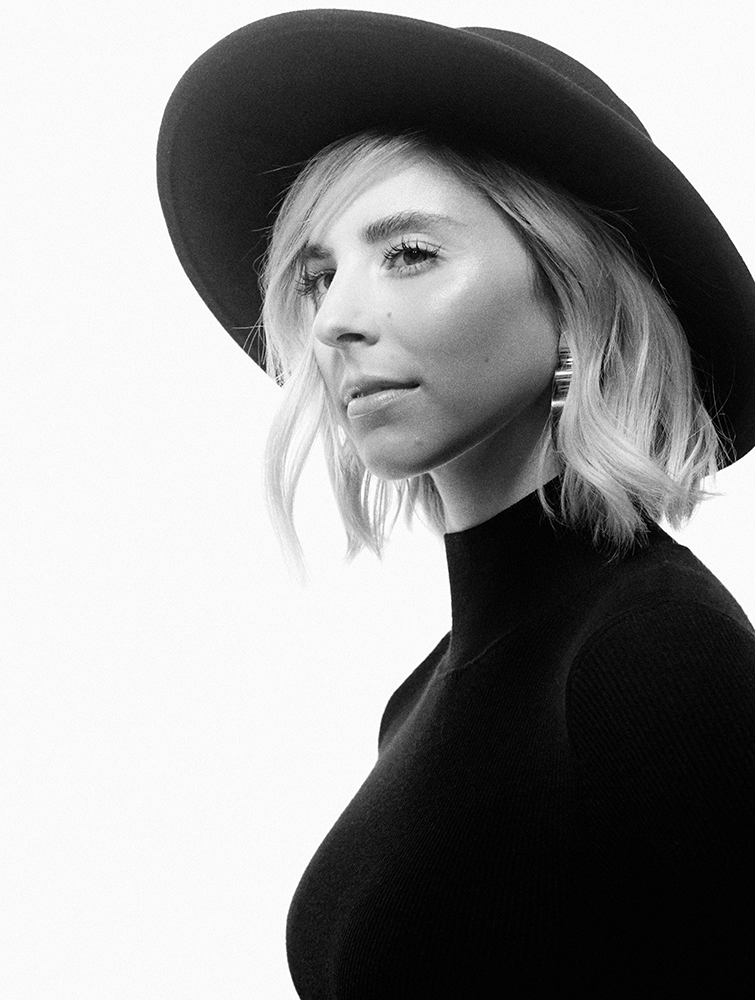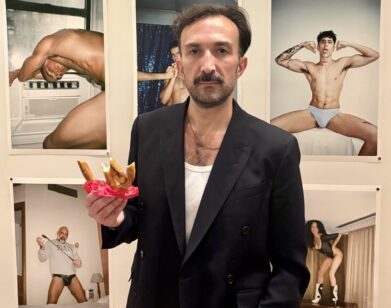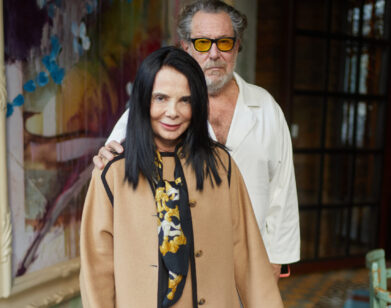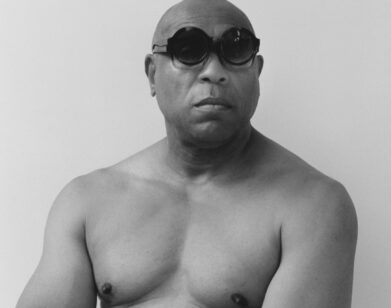Into the Cosmos
ELIZA MCNITT AT NATIONAL SAWDUST IN NEW YORK, MARCH 2017. PORTRAITS: DEAN PODMORE. STYLING: MARIE LAFFORT. HAIR: EVANIE FRAUSTO USING BUMBLE & BUMBLE. MAKEUP: CAITLIN WOOTERS USING BURBERRY BEAUTY. SPECIAL THANKS: FAST ASHLEYS.
“Welcome back to Earth,” says Eliza McNitt. The New York-based writer and director is greeting us following Fistful of Stars, a 5-minute, 360-degree virtual reality journey in which you’re transported to the Orion Nebula, over 1,300 light years away, to witness the birth, life, and death of a star. The extraterrestrial experience is McNitt’s first venture in VR, and it’s apparent that the 25-year-old has come a long way since her initial encounter with the medium in 2011 (which involved a nausea-inducing, albeit exhilarating, roller coaster simulation). In August 2016, thanks to a National Sawdust commission, McNitt premiered Fistful of Stars in Brooklyn during a performance of Paola Prestini’s operatic composition “The Hubble Cantata.” The audience, who viewed the piece through smartphones and Google Cardboard, reached over 6,000 participants, making the occasion the largest collective VR screening to date. Today a stand-alone version of the film makes its premiere in Austin, Texas at South by Southwest Film Festival.
In its new incarnation, two viewers at a time can experience the immersive work in Positron’s Voyager chairs. A shortened variant of the live score remains with an additional narration by astrophysicist Dr. Mario Livio, whose writing originally inspired Prestini’s opera. (McNitt emphasizes the importance of her collaborators on the project, including Livio, all of whom are all experts in their respective fields: Jess Engel, producer; Duncan Ransom, VR & VFX supervisor; and Terence Caulkins, sound designer.) The impulse to create Fistful of Stars traces back to McNitt’s childhood in Greenwich, Connecticut, during which she “fell in love” with the Hubble’s images. She unaffectedly describes making the film as “a dream come true.”
“You, as a creator, have to really get to the backbone of what your story is about, and you figure out how to tell that story in the best way possible,” explains McNitt of the VR process. She’s most interested in narrative storytelling within the medium, and her next project will be an episodic, interactive experience of outer space inspired by the famed 1990 photograph Pale Blue Dot, in which the Earth appears as merely a speck within space. Come June, viewers can watch Fistful of Stars on their own Samsung Gear devices as part of VICELAND’s series Beyond the Frame.
HALEY WEISS: How important was accuracy to you in making this, like using frequencies that exist in that space or transferring exact images of what the nebula looks like, versus creating the feeling of it?
ELIZA MCNITT: We wanted to create artistic representations of what it might be like to actually go there, and in collaboration with National Academy of Sciences, we’ve worked with different scientists who were able to communicate and visualize what it would be like if we went there. The best part is no one will ever know if we’re wrong, for now, until we figure out how to get there. [laughs] But this is what it would be like. What was so exciting for me was to be able to create a journey, to take people into the deepest pockets of the universe, over a thousand light years away, that only the Hubble Telescope gets to see—to do that for all of us earthlings.
WEISS: And you have a fascination with science that’s existed for a very long time. I read it started at a science fair in Connecticut?
MCNITT: That is correct. I did research on the disappearance of honeybees around the world. This actually started when I was 16. I was tracing the migration of a pesticide called Imidacloprid, which is the replacement for DDT, which is what Rachel Carson wrote Silent Spring about. I traced the migration of that pesticide through the pollination pathway of honeybees, and that was before entomologists or the U.S. military were looking into this issue, and it was something I stumbled on by accident. What I found is that this pesticide was playing a role in colony collapse disorder, but that was at a time before anyone even knew what CCD was. With that science fair project I was actually the winner of the Intel International Science and Engineering Fair, and I came back home and I told everyone about CCD, and no one even knew what it stood for. One of my best friends, Charlie Green, said, “I’m going to do this documentary for a class, but I don’t know what to do it on. Was there something that you might have an idea about?” And I was like, “Oh my gosh—why don’t we do it about colony collapse disorder? Because it’s something people really need to know about.” The competition was for President Obama, to tell him about the nation’s most pressing issue, and we made this documentary called Requiem for the Honeybee. We won this competition and our film was shown on C-SPAN [in 2009] to an international audience, and people from all over the world called in and said, “What can I do to help save the honeybees?” That made me realize the power of film, and how I could tell stories about science and technology through film.
WEISS: From that moment on, was it, “I’m going to school for film,” not, “I’m going to pursue science”? Was that ever a question?
MCNITT: It’s funny because when I was at the science fair everybody in my category, in environmental studies, my whole entire row was going to Harvard, and I was going to NYU’s Tisch School of the Arts for film, so I was always an outsider in both worlds—both in art and in science. But I think that’s what connects me to both worlds: to bring them together, but being sort of on the fringes of both. I never thought I was good at science; I was just really passionate about this idea. It wasn’t until I won the Intel Science Fair for the second time that I realized, “Maybe this is something I should really pursue.” And I chose to pursue science through an artistic lens and to use storytelling to talk about science and technology, and to really focus on the human drama behind science, because that’s what I’m mostly interested in.
WEISS: You’ve said before that you think “science is storytelling.”
MCNITT: Absolutely. I think I connect to science as if it’s an artistic process, and the process of discovery in science is the same experience you have when you’re making a film, because it’s all about failing upwards and having that lead to these new discoveries. That’s certainly the experience we had with creating virtual reality film; there was a lot of failing upwards in order to get there.
WEISS: Did you come across any people who were skeptical in thinking that science can’t be merged with the poetic in this way? … Was that a notion you had to contend with?
MCNITT: I think there is a general skepticism about the connection between science and art, and people look at them as two very separate entities. And for me, there is no question they are intrinsically connected, because they both fuel each other. I do think that people don’t look at it is as being in the same thing, but I think that is one of the big problems—it’s that they are so similar. We should approach science and art in the same way. I think that science should be taught as art, because that’s the same process. When I was coming up with my research project in high school, it’s the exact same creative process as inventing an idea for a film.
At my high school, which is really big, it takes 15 minutes to get from one end to the other. My high school has the theater and film wing at one side and then science on the opposite side, and think it’s representative of the way we think about science and art, when they should be something that’s together.
WEISS: A lot of the discussion around VR, especially the more documentary style works, is, “Is it a more empathetic space? Are you able to access a viewer’s emotions more easily because of the immersive experience?” Is that still an interesting question within VR?
MCNITT: VR is a tool for empathy, but furthermore, I think it’s a way for us to better understand ourselves. I think this is why I like telling stories about the cosmos in VR, because it’s a way to take you into a world that we as humans would never get to experience and make you feel as if you’re really there. VR as an empathy machine is something that I think has been exhausted. [laughs] I think we need to look forward to the future of how can we connect to each other through virtual reality instead of how can it give us empathy for characters in the film. How can we find empathy for ourselves? And I think this is the next big step: the multi-player social experiences. How can we connect to each other through virtual reality? When I talk about this new genre that’s really interesting of narrative storytelling, I think that’s what that is going to look like: it’s really connecting you and me, together, in an experience, and having that be a new form of storytelling.
WEISS: What’s the most interesting or weird thing you’ve learned about stars or space throughout this whole process?
MCNITT: Well, I have a weird fact for you that’s about stars: as a science fair winner, they awarded me with a star—well, actually, it’s a minor planet named after me. It’s really silly. It orbits somewhere between Jupiter and Mars, and it is called ElizaMcNitt as one word, so that is a funny thing. I’ve never found it—it’s a minor planet or an asteroid—so I’m on a quest to find that. The weirdest thing I’ve learned about stars… There are two things. I think first of all, humans and stars are truly connected, because the atoms in our bodies were forged inside of the furnaces of stars, and as it says in the film, “Therefore it is true, we literally are stardust.” And this idea that the cosmos is a way to connect us to ourselves; by looking out there into the cosmos, we have a deeper sense of our own planet and how fragile we really are. But I think one of the more interesting things that I’ve learned is that the Hubble Telescope is a time machine: through the light, you peer back in time, and you see the universe as it was billions of years ago. That’s totally fascinating to me, because that’s not the way it is now. We are just getting a glimpse into what once was.
WEISS: Have any reactions that viewers had to the experience stuck with you, like something that someone has said after coming out of it?
MCNITT: Yes. I recently showed a trailer for the experience at CES, [a technology tradeshow,] in collaboration with Intel, and there was a woman who—she didn’t speak much English, and CES is very tech-driven—so she put on the headset and she pulled it off within three seconds, and went, “It is not amazing.” [laughs] She was referring to the quality of the imagery, because you’re so used to seeing 4k images in film, and so I said to her, “Please, why don’t you try it, put on the headset, and just see what it might be like.” And at the end of it she came out crying, and it made me realize that for VR, it’s really about the story. And if you can invest yourself into the story, and look past some of the technological obstacles that we’re still figuring out, then maybe that might connect to you. But that was one of the funniest experiences, saying, “It is not amazing.”
WEISS: What was the script writing process like? And how did you choose the voice of the narrator?
MCNITT: That’s actually Dr. Mario Livio, who’s this amazing astrophysicist who worked on the Hubble Telescope for 24 years, and he was the advisor and the mentor for the project. He created the opera with Paola Prestini, who composed the music. There was no script. This is something I’m still trying to figure out: How do you write a script in VR and what does that look like? And it wasn’t words. It ended up being a lot of drawings. In film we write screenplays, but with VR I had to draw the whole film, because I couldn’t articulate what everything would look like, so it became much more a visual process of communication. But I did write the voiceover with Dr. Mario Livio, and that was a balance of wanting to create poetry through science but also wanting to be very accurate, and we went back and forth a lot. I would push him and see how far he would let me go with the poetry, and then he would push back with the science, and together we hopefully found a place where it’s both poetic but tells a story about science with a heart.
His ideas are really the heartbeat of the experience. Through his thoughts about science was where I drew a lot of the inspiration for the film, because it’s his idea that we, even though we are speck of dust in this grand cosmic scheme, it is us humans who discovered everything that’s out there. And even though we are unimportant in the scale of time, humans do play a role, because we are the ones who discovered what’s out there. That’s some way to think about our role in the universe—maybe we do play a tiny purpose.
FISTFUL OF STARS PREMIERES AT SOUTH BY SOUTHWEST FILM FESTIVAL TODAY, MARCH 14, 2017, AND WILL BE SCREENED THROUGH MARCH 16, 2017. IN JUNE IT WILL BE AVAILABLE ON SAMSUNG GEAR DEVICES THROUGH VICELAND’S BEYOND THE FRAME SERIES. FOR MORE ON ELIZA MCNITT, VISIT HER WEBSITE.







